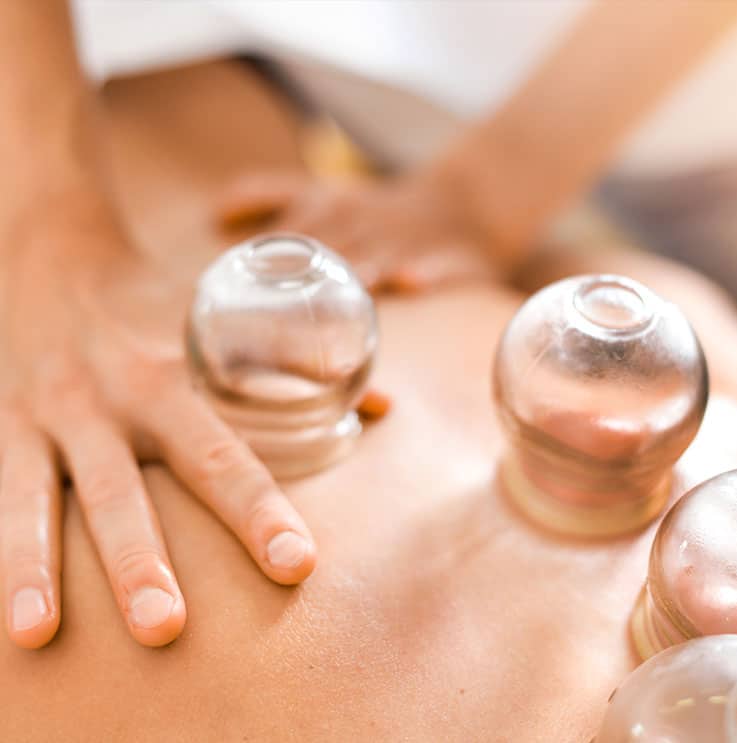Cupping Therapy Bolton
Cupping therapy, an ancient and holistic form of alternative medicine, involves creating a localized suction on the skin through the application of heated cups. This unique technique has roots that stretch deep into history, with its practice being a cornerstone of traditional healing methods across various cultures around the world. Primarily found in Asia, cupping therapy also boasts a significant presence in Eastern Europe, the Middle East, and Latin America, showcasing its global appeal and versatility in addressing a multitude of health concerns.
The method behind cupping therapy is both simple and intricate. Practitioners use cups made from glass, bamboo, earthenware, or silicone. These cups are heated using fire or a similar heat source before being placed directly onto the skin. As the air inside the cup cools, it creates a vacuum, drawing the skin and superficial muscle layer slightly into the cup. This process is believed to facilitate healing by promoting blood flow to the area, reducing inflammation, and alleviating pain.
Cupping therapy is utilized for a wide array of health issues. It is most commonly sought for pain relief, including headaches, back pain, and muscular stiffness. Beyond pain management, cupping is credited with enhancing immune system function, aiding in digestion, and even promoting skin health by improving circulation and potentially reducing acne and skin inflammation. Additionally, many turn to cupping therapy for respiratory conditions, believing it can help with the likes of the common cold, pneumonia, and bronchial congestion.
The practice of cupping has evolved over centuries, incorporating various techniques to cater to different ailments and preferences. Dry cupping, the most traditional method, involves just the suction process without any incisions. Meanwhile, wet cupping combines suction with controlled medicinal bleeding, aiming to remove harmful substances from the body. Another variant, moving cupping, involves gently moving the cup over the skin, similar to a massage, to enhance circulation in a larger area.
Despite its ancient origins, cupping therapy continues to be the subject of modern scientific research, with studies exploring its efficacy and mechanisms. While the practice is widely regarded as safe when performed by a trained professional, it's important for individuals to consult with healthcare providers to ensure it aligns with their specific health needs and conditions. As the interest in holistic and alternative medical practices grows, cupping therapy stands out as a fascinating blend of tradition and healing, offering a natural path towards health and well-being for those across the globe.
We accept MVA & WSIB claims.
Call to book an appointment.



Results
Cupping therapy, a traditional alternative healing technique, has garnered attention for its multifaceted health benefits, rooted in the practice of creating suction on the skin. Proponents of cupping therapy assert that this unique method offers a plethora of therapeutic advantages, each contributing to the overall well-being and health of an individual in a holistic manner.
One of the primary claims surrounding cupping therapy is its ability to effectively drain excess fluids and toxins from the body. This detoxifying effect is believed to occur as the suction from the cups encourages the lymphatic system to increase its activity, promoting the removal of waste and toxins. This detoxification process is crucial for preventing the accumulation of harmful substances that can lead to inflammation and other health issues.
Moreover, cupping therapy is said to loosen adhesions and rejuvenate connective tissue. Adhesions can form as a result of injury or surgery, leading to restricted movement and pain. The suction created by cupping can lift the skin and underlying tissues, helping to break down these adhesions, thereby restoring mobility and easing discomfort.
The enhancement of blood flow to the skin and muscles is another significant benefit attributed to cupping. By drawing the skin into the cup, the therapy encourages blood to rush to the affected area, enriching it with oxygen and nutrients. This increased circulation can accelerate the healing process, reduce muscle soreness, and improve overall skin health, giving it a vibrant and youthful appearance.
Cupping therapy is also believed to stimulate the peripheral nervous system, an effect that can have a calming influence on the body. This stimulation can reduce pain sensations by encouraging the release of endorphins, the body’s natural painkillers. As a result, cupping is often sought for its analgesic effects, providing relief from various types of chronic and acute pain.
Additionally, cupping has been linked to the modulation of the immune system. By stimulating both the lymphatic system and the body’s response to the suction, cupping therapy can potentially strengthen the immune system, making it more efficient in combating pathogens and diseases. This modulation includes the promotion of anti-inflammatory effects, which can further bolster the body’s defenses.
The practice is also credited with the ability to control high blood pressure, a prevalent health concern worldwide. By promoting relaxation and reducing stress, cupping therapy can indirectly contribute to the lowering of blood pressure levels, thereby reducing the risk of heart-related conditions.
Overall, the claims surrounding cupping therapy highlight its potential as a comprehensive treatment option that not only addresses specific physical ailments but also contributes to the improvement of general health and well-being. While scientific research continues to explore and validate these benefits, the holistic approach of cupping therapy remains a compelling aspect of alternative medicine, offering individuals a natural path towards healing and balance.
Common Conditions Treated with Cupping Therapy:
Cupping therapy stands as one of the oldest and most revered forms of healing, rooted in the ancient traditions of Chinese and Middle Eastern medicine. This therapy, embraced by various cultures for thousands of years, employs a unique method to alleviate pain and promote healing through the strategic placement of cups on the body. Practitioners of cupping therapy typically target the back, stomach, arms, legs, and other parts of the body, depending on the individual’s specific ailments and needs.
The process of cupping involves creating a vacuum within a cup placed on the skin. This is achieved either by heating the air inside the cup or using a mechanical device to create suction. Once the cup is securely placed on the skin, the cooler air outside the cup and the reduced pressure inside it work together to draw the skin and superficial layers of muscle upward into the cup. This action is not only fascinating to witness but also forms the core of cupping therapy’s healing properties.
Cupping is primarily recognized as a form of traditional Chinese medicine, where it has been practiced for millennia. According to Chinese philosophy, cupping helps balance yin and yang within the body, thus restoring and maintaining health. It’s believed that this balance is essential for the flow of “qi” or life force, which, when obstructed, can lead to illness and discomfort. By stimulating the flow of qi, cupping is said to promote healing and reduce pain.
Similarly, in Middle Eastern cultures, cupping therapy has been a staple in traditional healing practices. It is often used in conjunction with other forms of alternative medicine, such as herbal remedies and massage, to treat a wide range of conditions, including pain, inflammation, blood disorders, and emotional disturbances.
Beyond its traditional roots, the appeal of cupping therapy in modern times can be attributed to its holistic approach to health. Unlike treatments that focus solely on alleviating symptoms, cupping aims to address the underlying causes of pain and disease. By improving circulation, enhancing tissue oxygenation, and facilitating the removal of toxins, cupping supports the body’s natural healing processes. It’s also believed to strengthen the immune system and promote relaxation and well-being by reducing stress.
Cupping therapy’s versatility allows it to be adapted to treat various conditions. For pain relief, cups might be placed on specific points known to be pain centers or along the meridians of the body, similar to the principles of acupuncture. This targeted approach helps to relieve muscle tension, reduce soreness, and ease joint pain. Furthermore, the practice has expanded to include different cupping techniques, such as dry cupping, wet cupping, and moving cupping, each offering unique benefits and suited to different therapeutic needs.
As interest in holistic and alternative therapies continues to grow, cupping therapy remains a sought-after treatment for those looking to alleviate pain and enhance their overall health and well-being. Its rich history, combined with its potential health benefits, makes cupping a fascinating and enduring element of traditional medicine practices worldwide.
Pregnancy
During pregnancy, avoid cupping to the lower and upper abdomen; the lower back can be cupped until the sixth month of pregnancy, using Light or Medium cupping methods only.

Wish To Book An Appointment?
To book an appointment, please call 905.857.7773 or click on the button below!